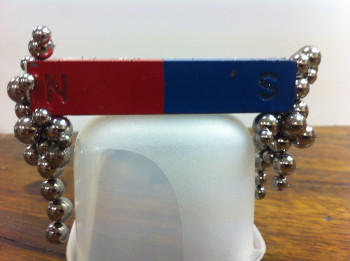15.1 Introduction
|
Previous
End of chapter exercises
|
Next
15.2 Magnetic fields
|
Chapter 15: Magnetism
15.1 Introduction (ESAEF)
Magnetism is an interaction that allows certain kinds of objects, which are called 'magnetic' objects, to exert forces on each other without physically touching. A magnetic object is surrounded by a magnetic 'field' that gets weaker as one moves further away from the object. A second object can feel a magnetic force from the first object because it feels the magnetic field of the first object. The further away the objects are the weaker the magnetic force will be.
Humans have known about magnetism for many thousands of years. For example, lodestone is a magnetised form of the iron oxide mineral magnetite. It has the property of attracting iron objects. It is referred to in old European and Asian historical records; from around \(\text{800}\) BCE in Europe and around \(\text{2 600}\) BCE in Asia.
Magnetic objects stuck to a magnet

The root of the English word magnet is from the Greek word magnes, probably from Magnesia in Asia Minor, once an important source of lodestone.
|
Previous
End of chapter exercises
|
Table of Contents |
Next
15.2 Magnetic fields
|
